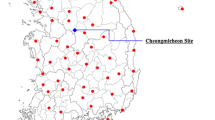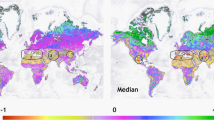Abstract
Drought is a stochastic natural hazard that is caused by intense and persistent shortage of precipitation. Spatial and temporal patterns of drought have been analyzed by several methods, ranging from satellite images to historical records; however, drought is generally identified by climate elements. Drought indices are quantitative measures that characterize drought levels by assimilating data from one or several variables (indicators). A number of different indices have been developed to quantify droughts, each with its own strengths and weaknesses. In this paper, using the remote sensing image to acquire the vegetation cover data, and combined with meteorological data and the Geographic Information System (GIS) technology to discuss the spatial and temporal characteristics of the drought. Based on precipitation observations Pu’er City, Yunnan Province, ten counties (districts) ten meteorological observation stations from 1961 to 2010 monthly for 50 years, mainly in ArcGIS10.1 analysis platform, using Mann–Kendall nonparametric trend test method for time-series trends in precipitation was tested, using ArcGIS in inverse distance weighting interpolation tool were precipitation the amount and distribution of precipitation anomaly percentage. Finally, precipitation anomaly percentage grading standards drought intensity distribution of drought The results showed that: Pu’er City under the effect of temperature, altitude, vegetation cover, and many other factors, forming the situation that the rainfall is a little more in north–south and less in east–west, the drought incidence appears more in northwest and less in southeast, more in spring and winter and less in summer and fall.






Similar content being viewed by others
References
Tan, X.Z.: Su Xiaoling head of the Middle Meteorological temporal characteristics of drought in Guanzhong SPI-based analysis. Agric. Res. 29(2), 224–229 (2011)
Yevjevich, V.: An Objective Approach to Definitions and Investigations of Continental Hydrologic Droughts. Colorado State University, Fort Collins (1967)
Andreadis, K.M., Clark, E.A., Wood, A.W., Hamlet, A.F., Lettenmaier, D.P.: Twentieth-century drought in the conterminous United States. J. Hydrometeorol. 6(5), 985–1001 (2005)
Lloyd-Hughes, B.: A spatio-temporal structure-based approach to drought characterisation. Int. J. Climatol. 32(2), 406–418 (2012)
Xu, K., Yang, D., Yang, H., Li, Z., Qin, Y., Shen, Y.: Spatio-temporal variation of drought in China during 1961–2012: a climatic perspective. J. Hydrol. 526, 253–264 (2015)
Feng, Y.: Interpret Meteorological Experts Yunnan Arid. China Meteorological News, Beijing (2012)
Wang, J.-W., Nan, Y.: Temperature. Drought Situation Analysis in Yunnan [EB/OL].2013 [2013-04-17]. http://wenku.baidu.com/link?url=JU3JUTCd7mrCgnDwZKYm5l6LZeHvF992GpQE2yEYsuuwTdNZTHfr6qmnYDq78hj0m5kcOC1k2anu9lSIDfKsEHTF_D664ssxBk1aIUTe. A comparative study (2013)
Mei, L.Y., Ying, H., Jie, W.: Characterize meteorological droughts in Yunnan Yunnan Area. Agric. Sci. 40(18), 9799–9801 (2012)
Yan, F., Wang, Y.J., Wu, B.: Drought spatial and temporal distribution of nearly 50 years in Hebei Province. Geogr. Res. 29(2), 423–430 (2010)
Zhou, J.H., Li, L., Qin, A.: Determine Shanxi meteorological drought index and drought climate change research. Agric. Res. 28(2), 241–247 (2010)
Majian, Q., Han, X., Xia, J., Liu, X.: Multiscale temporal and spatial variation of meteorological drought in Gansu Province. Hydroelectr. Energy Sci. 31(5), 29–32 (2013)
Madadgar, S., Moradkhani, H.: A Bayesian framework for probabilistic seasonal drought forecasting. J. Hydrometeorol. 14, 1685–1705 (2013), special issue of Advances in Drought Monitoring, doi:10.1175/JHM-D-13-010.1
Han, H., Hu, W., Chen, X., et al.: Application of three meteorological drought index. Agric. Res. 27(1), 237–247 (2009)
Luo, X., Xu, Z., Yu, J., Chen, X.: Building association link network for semantic link on web resources. IEEE Trans. Autom. Sci. Eng. 8(2), 482–494 (2011)
Hu, C., Xu, Z., et al.: Semantic link network based model for organizing multimedia big data. IEEE Trans. Emerg. Topics Comput. 2(2), 376–387 (2014)
Xu, Z., et al.: Knowle: a semantic link network based system for organizing large scale online news events. Future Gener. Comput. Syst. 43–44, 40–50 (2015)
Xu, Z., Luo, X., Wang, L.: Incremental building association link network. Comput. Syst. Sci. Eng. 26(2), 153–162 (2011)
Xu, Z., et al.: Crowdsourcing based description of urban emergency events using social media big data. IEEE Trans. Cloud Comput. (2015). doi:10.1109/TCC.2016.2517638
SL424-2008: Drought Grading Standards. China Water Power Press, Beijing (2008)
Kang, S., Zhang, B., Liu, J., Yang, M.J.: Analysis spatial and temporal distribution of precipitation in Zhangye City, Mann-Kendall-based method. Resour. Sci. 31(2), 501–508 (2009)
Xu, Z.X., Takeuchi, K., Ishidaira, H.: Monotonic trend and step changes in Japanese precipitation. J. Hydronaut. 279, 144–152 (2003)
Xu, J.: Quantitative Geography. Higher Education Press, Beijing (2006)
Wikipedia. Pu’er City [EB / OL].2014 [2014-05-13]. http://zh.wikipedia.org/wiki/%E6%80%9D%E8%8C%85%E5%B8%
Zhao, R., et al.: Evolution characteristics Tianshan area for nearly 50 years drought index. Sci. China Inst. Water Resour. Hydropower Res. 2(7), 88–106 (2010)
Cui: Water Resources and Hydrological Analysis and Calculation. China Water Power Press, Beijing (2004)
News of China Yunnan forest coverage of the dispute [EB/OL].2012 [2014-03-01]. http://news.timedg.com/2012-03/01/content_8781125.htm
Xu, N., Ding, J., Liu, H.: Vegetation information extraction based on NDVI and LSMM the Arid Zone Research—Turpan in Xinjiang Province. Surv. Spat. Inform. Technol. 35(6), 52–57 (2012)
He, Q., Yong-Hua, H., et al.: Mountainous arid and semiarid zones of soil moisture. Mount. Sci. 21(2), 149–156 (2003)
Niemeyer, S.: New drought indices in drought management: scientific and technological innovations. In: Proceedings of the 1st International Conference Drought management: Scientific and Technological Innovations, pp. 267–274 (2008)
Shukla, S., Steinemann, A.C., Lettenmaier, D.P.: Drought monitoring for Washington state: indicators and applications. J. Hydrometeorol. 12, 66–83 (2011)
Moradkhani, H., Meier, M.: Long-lead water supply forecast using large-scale climate predictors and independent component analysis. J. Hydrol. Eng. 15(10), 744–762 (2010)
Karl, T., Quinlan, F., Ezell, D.S.: Drought termination and amelioration: its climatological probability. J. Clim. Appl. Meteorol. 26(9), 1198–1209 (1987)
Palmer, W.C.: Meteorologic Drought. Research Paper No. 45. U.S. Department of Commerce, Weather Bureau, Washington, DC (1965)
Steinemann, A.: Drought indicators and triggers: a stochastic approach to evaluation. J. Am. Water Resour. Assoc. 39(4), 1217–1233 (2003)
Barros, A.P., Bowden, G.J.: Toward long-lead operational forecasts of drought: an experimental study in the Murray-Darling River Basin. J. Hydrol. 357, 349–367 (2008)
Cancelliere, A., Mauro, G.D., Bonaccorso, B., Rossi, G.: Drought forecasting using the Standardized Precipitation Index. Water Resour. Manag. 21, 801–819 (2007)
Hwang, Y., Carbone, G.J.: Ensemble forecasts of drought indices using a conditional residual resampling technique. J. Appl. Meteor. Climatol. 48, 1289–1301 (2009)
Acknowledgments
Ministry of Education, “Chun Hui Plan” Foundation, China (No. Z2012051) and the Yunnan University Resource Environment and Earth Science research project, China (No. 2013CG006, 2014JC004), The Scientific Research Project of Department of Education of Yunnan Province of China (No. 2015Y004), National Natural Science Foundation of China (No. 41361020) funded.
Author information
Authors and Affiliations
Corresponding author
Rights and permissions
About this article
Cite this article
Xu, X., Xie, F. & Zhou, X. Research on spatial and temporal characteristics of drought based on GIS using Remote Sensing Big Data. Cluster Comput 19, 757–767 (2016). https://doi.org/10.1007/s10586-016-0556-y
Received:
Revised:
Accepted:
Published:
Issue Date:
DOI: https://doi.org/10.1007/s10586-016-0556-y




